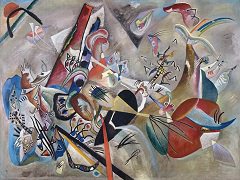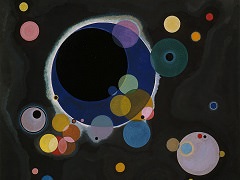Striped, 1934 by Wassily Kandinsky

Although Kandinsky arrived in Pans in the Autumn of 1933, he did not begin pointing again until February of the following year almost certainly traumatized by his enforced exile from Germany, his adopted country for almost all of his working life. At this time Paris was also torn by political unrest. Although this was not as severe as in Germany, there were still right-wing groups trying to oust the present Socialist government, which led to rioting on Poris's streets in February 1934.
In Paris, Kandinsky maintained his contacts with artists, some like him living in exile such as Laszlo Moholy-Nagy, and others such as Piet Mondrian living there to be at the centre of the European avont-garde.
In Striped, Kandinsky utilizes a Constructivist base of black and white that clearly shows a debt to Mondrian's use of black intersecting lines on a white background, as in Mondrian's Tableau No. IV . The work also shows the influence of biomarphic form by Joan Miro. Miro belonged to the Abstraction-Creation group that Kandinsky associated with prior to his arrival in Paris, on association he was keen to continue.
















